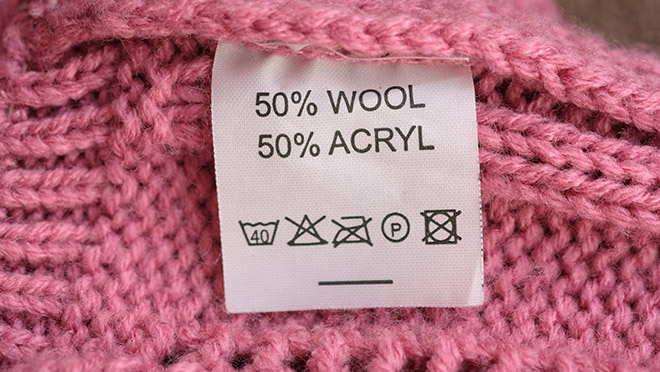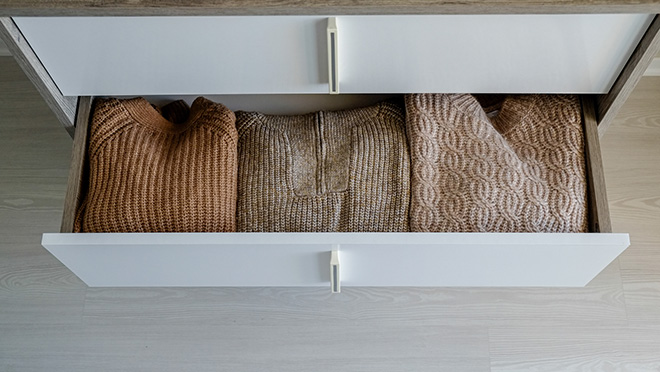Beyond the ugly sweater: 10 things you should know

Sweaters aren't created equal, and it's not even close
A recent story in The Atlantic magazine, under the provocative headline 'Your sweaters are garbage', delved deeply into how sweaters just aren't the comfy, well-made articles of old. It specifically cited the cream cable-knit sweater Billy Crystal rocked in 1989's Harry Met Sally as an example of what we've lost.
Here at BC Hydro, we talk a lot about sweaters, which are a great way to stay warm at home without cranking up the thermostat. So we're taking inspiration from that Atlantic piece to offer some tips on buying (and caring for) a quality sweater that will provide comfort and style – with a dollop of sustainability – at home and away. Read on for our best tips.
1. Natural fibres are best
In terms of comfort and sustainability, nothing beats natural fibres, from wool, to organic cotton to bamboo. Synthetic knits (acrylic, polyester, etc.) often look great at first, and are usually inexpensive... two big reasons they so often end up in the donation bin or landfill after a year or two of use. They lose their shape in the wash, pill quickly, shed microplastics into your washing machine and then into our oceans and lakes.
Natural fibres, especially wool from sheep, goats, or alpacas, are warm, even when wet. They also tend to be more sustainable and ethically-sourced, although a lot of that depends on the brand's commitment to those priorities. More on that below.
2. Wool for winter, cotton for summer
Rule of thumb: cotton isn't going to keep you that warm, but its affordability and durability makes it a great practical choice for summer, unless you're working up a sweat. Wool and synthetics wick away moisture from your skin, while cotton tends to stay wet. In winter and in wet weather, lean in on wool, which is the king of warmth, with alpaca and merino at the top of the warmth list.

3. Check the label, then check it again
A lot of claims of 100% wool don't stand up to scrutiny. Even premium brands of wool sweaters are often blended with synthetics, and low-priced cashmere sweaters tend to have a low percentage of cashmere. You tend to get what you pay for, but some pricey luxury brands still skimp on natural fibres. Learn the basics of wool types, and again, check those labels to see exactly what an item is made of.
4. Not all wool or bamboo is sustainable or ethical
From the way animals are treated, to the carbon emission impacts of raising sheep, to the way workers are treated, wool in particular gets a lot of scrutiny. Do your research and beware of greenwashing. At the very least, look for the RWS label (Responsible Wool Standard), a voluntary standard around animal welfare and environmental issues.
Close to home, Victoria-based Ecologyst seems to tick a lot of boxes with their 100% wool clothing, as they use Canadian-milled wool (and buttons made from palm trees instead of plastic), and they're a certified B Corp. Popular B.C.-based Anian is all about using recycled natural fibres, and their website breaks down exactly what each garment is made of. And Vancouver-based Tentree, which plants trees for each product sold, uses an assortment of recycled fibres for its sweater line.
Bamboo is a nicely renewable resource, but a lot of bamboo clothing (and bed linens) aren't as sustainable as they tend to be blended with cotton and are often made of bamboo viscose or rayon, the product of a resource-intensive chemical process. Bamboo lyocell is generally made from bamboo pulp (like viscose or rayon), but is considered compostable and biodegradable.
With cotton, organic cotton is the more sustainable choice because it takes pesticides out of the equation. But while cotton is biodegradable (when not combined with synthetics), conventional cotton production methods use a lot of water and can cause soil degradation. Processing uses chemicals and a whole lot of energy.
5. Resist washing wool, and hand wash when you do
Lanolin rich, good quality wool can last for many years (or decades) when washed infrequently, and by hand. One wash per year makes sense for 100% wool sweaters. Merino wool base layers can be hand-washed more often, but their odour-reducing magic allows you to wear them repeatedly before washing.
6. Active outdoors? Use merino wool as a base layer
Merino wool base layers are all the rage for a reason. Finer than most other wool fibres, merino is lauded for insulating while remaining breathable and odour resistant, which allows you to wear a base layer repeatedly before washing. That also makes it great for travel. Synthetic base layers wick well, too, but don't control evaporation as well as merino. And wool is biodegradable.
7. Sensitive to wool? Try cotton, bamboo, or synthetics
Finer wools including merino, cashmere and alpaca, are best bets for those that feel the itch when wearing wool. Soft and hypoallergenic, bamboo is a great (albeit pricey) way to avoid the itch, is generally warmer, and deals with moisture much better than cotton. If you must, opt for itch-free synthetics, but keep in mind that you're buying plastics that can take more than 200 years to decompose in a landfill.

8. Don't hang sweaters. Fold, then store in a drawer
Hanging your sweaters can stretch them. Instead, fold them properly, and store them in a dry place, preferably in a drawer or closet. For seasonal storage, clean your wool sweaters, fold them, and encase them in cloth or vacuum-packed storage bags that guard against moths and dust.
9. Layer up at home to save on energy
Heat the person, not the space. To stay comfortable at home in the cooler months of the year, get everyone in the home to wear sweaters and/or hoodies, preferably in layers. We know that the "right" temperature varies from person to person, and depends a lot on how active you are in the home. Layering allows you to strip a layer while doing housework or while in the kitchen, where the last thing you want to do is to splash bacon grease on a nice sweater or light-coloured top. And don't forget slippers, a small item with outsized potential to keep you warm.
As a guideline, we suggest setting your thermostat at...:
- 16°C overnight or when you're away from home
- 18°C when you're in the kitchen, doing housework, or at-home exercise
- 21°C when you're sedentary, such as working on the laptop or watching TV
10. Gently used items get reused, but others wind up in the landfill
Fast fashion is considered the second largest polluter in the world, after oil. Buying clothes that last longer (and fewer clothes overall) is a great way to reduce that damage, but donating gently used items should be your go-to when you're done with a piece of clothing. If an item is in good condition (no stains, holes, or tears) and is clean, it could be a great candidate for consignment or for a thrift shop donation.
Also look to mending or using your clothes as utility rags, and see Metro Vancouver's Think Thrice About Clothes site for details about what to donate/recycle (no underwear, please), what to repair, and how to reduce the number of clothes you buy.